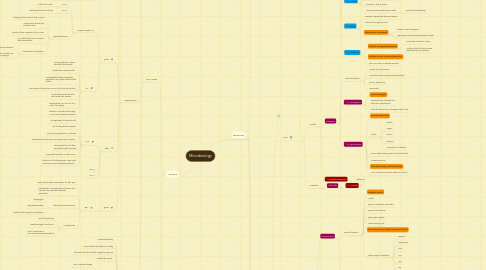
1. Bacteria
1.1. gram positive
1.1.1. cocci
1.1.1.1. Aerobic
1.1.1.1.1. Staphylococci
1.1.1.1.2. Streptococci
1.1.1.2. Anaerobic
1.1.1.2.1. peptococcus
1.1.1.2.2. peptostreptococcus
1.1.2. bacilli
1.1.2.1. Aerobic
1.1.2.1.1. Corynebacteria
1.1.2.1.2. Listeria
1.1.2.1.3. Bacillus
1.1.2.2. Anaerobic
1.1.2.2.1. Clostridia
1.2. gram negative
1.2.1. cocci
1.2.1.1. Aerobic
1.2.1.1.1. Neisseriae
1.2.1.1.2. Moraxella catarrhalis
1.2.1.2. Anaerobic
1.2.1.2.1. Veillonella
1.2.2. bacilli
1.2.2.1. aerobic
1.2.2.1.1. Pseudomonas
1.2.2.1.2. Fastidious
1.2.2.1.3. Enterobacteriaceae
1.2.2.2. Anaerobic
1.2.2.2.1. Bacteroides
1.2.3. other (gram - but doesn't stain)
1.2.3.1. Chlamydia
1.2.3.1.1. General features
1.2.3.1.2. C. tracomatis
1.2.3.1.3. C. pneumoniae
1.2.3.1.4. C. psittaci
1.2.3.2. Spirochetes
1.2.3.2.1. general features
1.2.3.2.2. Treponema pallidum
1.2.3.2.3. Borrelia
1.2.3.2.4. Leptospira
1.3. Myobacteria
1.3.1. General features
1.3.1.1. large cylindrical bacteria
1.3.1.2. Cannot get stained by Gram
1.3.1.3. sensitive to UV light
1.3.1.4. stained by Ziel-Neelsen stain
1.3.2. M. Tuberculosis
1.3.3. M. Leprae
1.3.3.1. Leprosy
1.3.3.2. from direct contact (patients or animals)
1.3.3.3. deformities of the nose and skin
1.3.4. M. fortutum
1.3.5. M. aviaum
2. viruses
2.1. DNA viruses
2.1.1. Adenoviridiae
2.1.1.1. Double stranded DNA
2.1.1.2. Icosahedral viral capsid
2.1.1.3. infect humans and animals
2.1.1.3.1. organs affected
2.1.1.3.2. attaches through capsular knobs
2.1.1.3.3. inters through endocytosis (receptor mediated)
2.1.1.3.4. viral replication kills the cell
2.1.1.4. Clinical infections
2.1.1.4.1. Acute upper respt. tract infection
2.1.1.4.2. Ocular infection
2.1.1.4.3. Gastrointestinal
2.1.1.4.4. RARE infections
2.1.2. Herpesviridiae
2.1.2.1. General features
2.1.2.1.1. enveloped double stranded DNA
2.1.2.1.2. LARGE DNA
2.1.2.1.3. Capsid is icosahedral
2.1.2.1.4. Tegument contains enzymes
2.1.2.1.5. Infection lead to latency
2.1.2.1.6. Viral cycle follow the enveloped DNA cycle
2.1.2.2. alpha
2.1.2.2.1. Herpes simplex 1,2
2.1.2.2.2. VZV
2.1.2.3. beta
2.1.2.3.1. CMV
2.1.2.3.2. HHV-6
2.1.2.3.3. HHV-7
2.1.2.4. gama
2.1.2.4.1. EBV
2.1.3. Hepadnaviridiae
2.1.3.1. enveloped partly
2.1.3.2. circle double stranded DNA partly
2.1.3.3. the short strand is half the negative long one
2.1.3.4. Icosahedra capsid
2.1.3.5. DNA encode
2.1.3.5.1. DNA capside antigen
2.1.3.5.2. envelop antigen
2.1.3.5.3. reverse transcriptase
2.1.3.5.4. non-structural regulatory protein X
2.1.3.6. Hepatitis B virus
2.1.3.6.1. parenteral transmission
2.1.3.6.2. Liver damage due to immunological reaction
2.2. RNA viruses
2.2.1. Orthomyxoviridae (flu)
2.2.1.1. General features
2.2.1.1.1. Negative strand
2.2.1.1.2. 8 segments
2.2.1.1.3. spherical enveloped
2.2.1.1.4. 2 spikes proteins
2.2.1.1.5. M protein underlay the viral lipid membrane
2.2.1.1.6. replication occur in the nucleus
2.2.1.1.7. 3 groups A,B,C
2.2.1.2. Influenza
2.2.1.2.1. infection through resp. droplets
2.2.1.2.2. restricted in the resp. tract
2.2.1.2.3. symptoms
2.2.1.2.4. damage to resp. epithelial cells
2.2.2. Paramyxoviridae (measles and mumps)
2.2.2.1. general features
2.2.2.1.1. ss negative
2.2.2.1.2. spherical enveloped
2.2.2.1.3. Helical nucleocapsid
2.2.2.2. Mumps
2.2.2.2.1. respiratory infection
2.2.2.2.2. 30% subclinical
2.2.2.2.3. infects parotid salivary glands and enlarges it
2.2.2.2.4. can escape to other parts of the body
2.2.2.3. Measles
2.2.3. Flaviviridae
2.2.4. Retroviridea (HIV)
